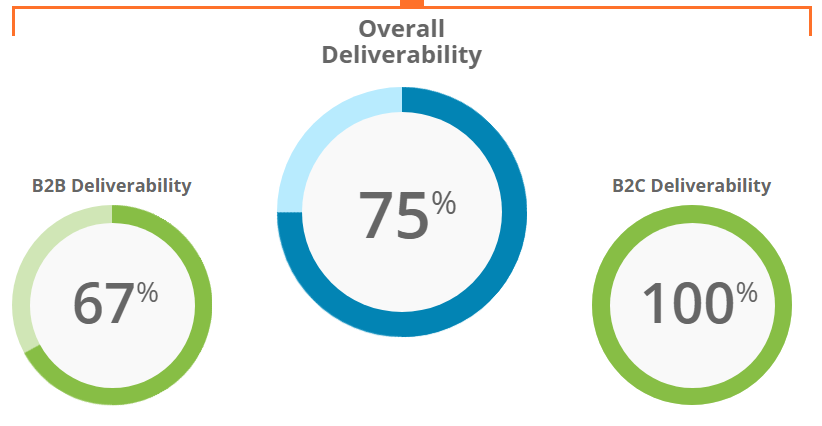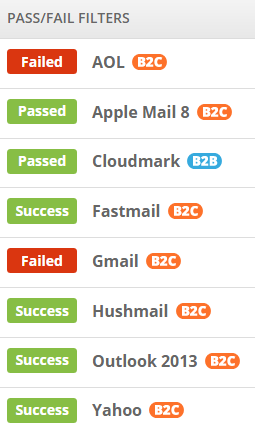Email Deliverability
Is 100% Email Deliverability Possible?

Email Deliverability

As email marketers, we’re always striving to improve our email deliverability. It’s one of those constant worries gnawing at us – will my message reach the inbox?

Recently, we were chatting deliverability on social media and came across an interesting question: “Can I achieve 100% deliverability?”
This query left us scratching our heads. So, we decided to call up the deliverability experts at Inbox Pros to see what they had to say.
“One-hundred percent deliverability is something that concerns email marketers from mom and pop shops to large corporations,” says Nathan She, deliverability tech lead with Inbox Pros. “While we strive to achieve 100% deliverability, it’s not something that’s realistic or something that you must have.”
We should pause here to clarify that deliverability is different from delivery. Delivery means your email was received by the client, even if it lands in the spam folder. An email bounce would mean the email isn’t delivered. Deliverability, on the other hand, is whether your email makes it to the inbox.
So, with that in mind, a 100% deliverability rate means you also need a 100% delivery rate.
“There are always factors at play that affect deliverability,” says Emily Standridge, an Inbox Pros deliverability strategist. “Things like email client updates and email address changes all make it impossible to get consistent 100% deliverability.”
Well, it sounded like a good answer…but we couldn’t leave well enough alone. We asked a few more questions to dig deeper into deliverability.
A 100% deliverability rate means the email not only makes it to the subscriber, it also lands in the inbox.
“I like to strive for above 95% deliverability,” She says. “Unfortunately, there isn’t a fool-proof way to calculate this percentage, but if you’re sending to an engaged audience and keep your list healthy, the deliverability rate will roughly be that of your delivery rate.”
With that goal in mind, marketers should also aim for a bounce rate of under 4% and an unsubscribe rate under 1%, She adds. The key word here is list health (more on that later).

If you’re not using a platform or service that provides a specific deliverability metric, there are other ways to assess your deliverability.
For example, if you see a large drop in open rates, it could indicate that your emails are hitting the spam folder instead of the inbox. Large discrepancies between click-through rate and open rate may also mean that your deliverability isn’t where it should be.
As She mentioned earlier, both hard and soft bounces should make up less than 4% of your total emails sent. A hard bounce means the recipient didn’t get your email at all (likely an incorrect email address). A soft bounce is usually a temporary delivery problem such as the email server being down, or the email message is too large.
[Learn more about how Inbox Pros use email testing to improve clients’ email deliverability and ROI]
Marketers should also keep an eye on unsubscribe rates and keep those under 1%.
“Unsubscribe rates are a direct correlation with email engagement,” She says. “If you see that percentage creeping up, it means what you’re doing isn’t appealing to your subscribers.”
We’ve talked before about the type of content that can land your email in the spam folder. Words with all capital letters (i.e. “SIGN UP NOW”), lots of exclamation points, default content or phrases like “call now” can all trigger spam filters.
“We all know what a spammy email looks like, so try not to replicate it,” Standridge says. “Think about whether you would open the email if it landed in your inbox – it probably wouldn’t include tons of emojis, phrases like ‘spend money now’ or have ‘free’ written over and over.”
Running a spam test with Email on Acid can give you a good idea as to how your email is doing and whether you need to change some content.

Aside from Content, She says list health is a crucial piece in email deliverability. Marketers should always be looking at their subscriber lists and cleaning them up to avoid hard bounces or users who are no longer interested in their content. As our CEO says, “always be scrubbin’.”
A longer email list ≠ more revenue, She adds.
“A small, very engaged, healthy list is better than a big list that’s made up of people who stopped engaging with your email or are no longer using that email address,” She says.
The more bounces you get from an email send, the worse off your reputation. This means your email is more likely to land in the spam folder.
However, both She and Standridge clarify that every industry has different standards for engaged subscribers. In some seasonal industries, for example, unengaged contacts may be typical during times of the year where your product or service isn’t needed.
“A healthy list varies company by company,” Standridge adds. Nevertheless, it’s still important to make sure your list is as clean as possible, regardless of seasonality.
Marketers should also pay attention to send frequency, She says, and to make sure to be as consistent as possible. If you typically send to a list twice a week, don’t suddenly start sending to the same list five times per week.
“Having a consistent send pattern will develop trust with the internet service provider (ISP) and email recipient,” She says.
Aside from these deliverability do’s and don’ts, She says it’s also important to run spam tests often, as can help give you an idea as to whether your deliverability is on the right track.
“Be thorough with your spam testing,” She says. “Even if you’re a small organization, make sure you are running spam tests, whether it’s through a third-party service, a seed list, or sending it to your own inbox.”